Sriracha is one condiment we always have stocked in the fridge. This is our homemade sriracha sauce recipe, which we find to be as good as (if not better) than the famous Huy Fong version.
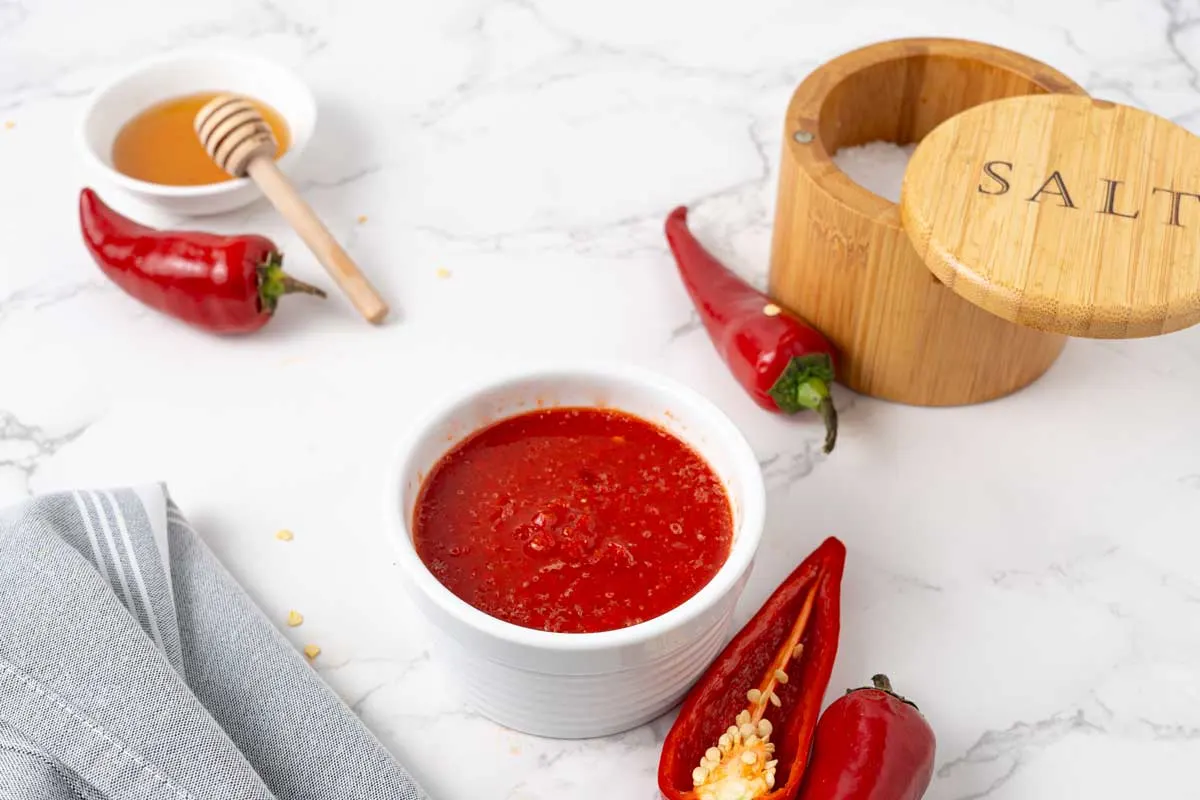
In Vietnamese and Thai cuisine, sriracha is most commonly used as a dipping sauce or condiment for soups, noodles, and seafoods. It’s also become a popular condiment in the US for burgers, fries, and tacos.
Sriracha was first introduced in Thailand in the 1940s in the town of Si Racha. Any guesses as to where the name for this hot sauce came from? However, the famous “rooster sauce” as we know it was actually developed in the 1980’s by David Tran, a Chinese-Vietnamese immigrant.
Using peppers grown on his brothers farm, David Tran began dabbling in homemade sauces during the mid 70’s. Shortly after, Huy Fong foods (and our beloved rooster sauce) was born.
Fun fact: The rooster on the bottle refers to the year David Tran was born (1945), “the year of the rooster.”
Due to supply issues, there have been multiple sriracha shortages reported over the years. We remember seeing bottles of sriracha listed for as high as $60 on eBay during the peak of the shortages! So, what is a pepper geek to do when one of their favorite condiments is difficult to find? Make your own of course!
Our homemade sriracha sauce is the perfect solution to bland food (or any sriracha shortage that may creep up again).
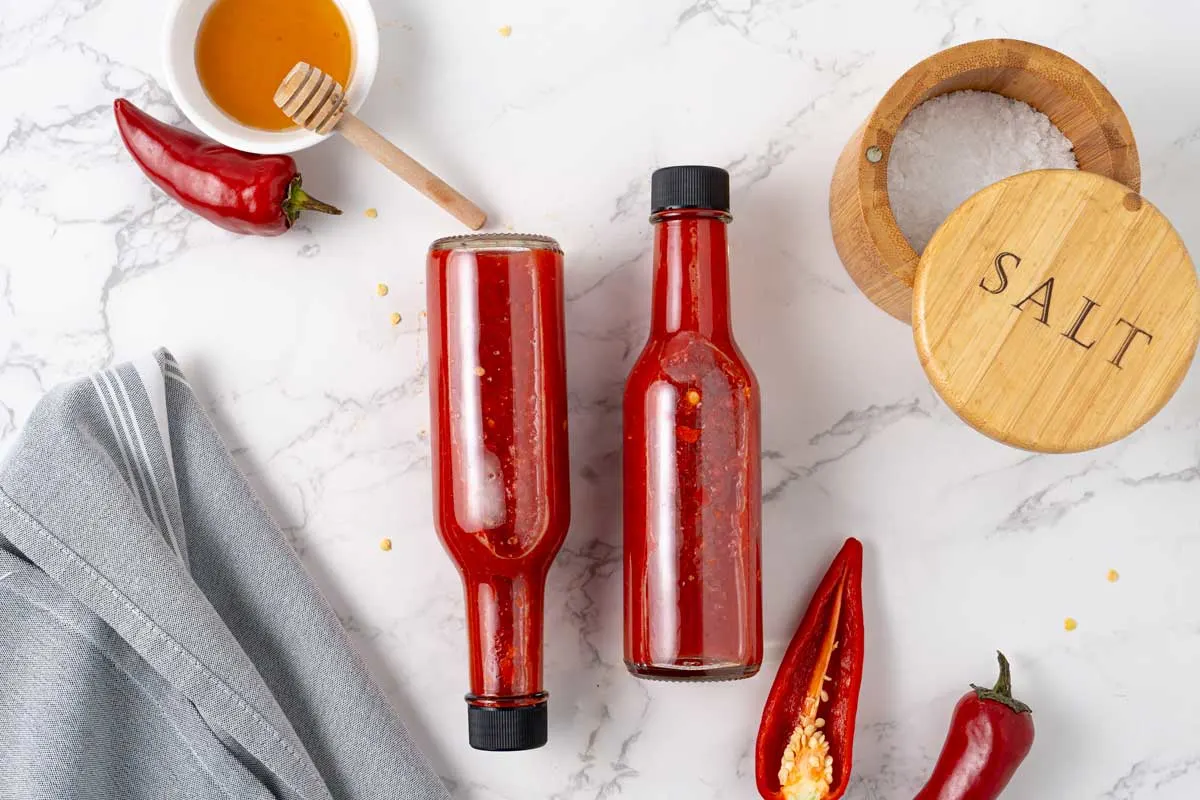
Ingredients list
All of the ingredients to make your own homemade sriracha can be found at the grocery store. For the peppers, I suggest checking a specialty market like Whole Foods, or even better, your local farmer’s market.
Ingredients:
- 1.5 lb. red hot peppers – classic sriracha is made with red jalapeño peppers. But, red jalapeños can be difficult to find unless you are growing your own. Red Fresno chiles, with their comparable color and heat level, are a perfect substitute.
- 3 large garlic cloves – fresh garlic cloves are fermented with the peppers for the best flavor payoff.
- 2 tbsp white sugar – while not as sweet as sweet chili sauce, sriracha is a sweet sauce, so a bit of sugar is needed.
- 1 Tbsp. kosher salt – salt is required not only for flavor, but for the fermentation process as well.
- 1/2 cup water (distilled or spring) – tap water can contain chlorine, which may hinder fermentation.
- 1/2 cup rice vinegar – many recipes call for white vinegar or apple cider vinegar. But, after experimenting, we loved the way rice vinegar tasted in this hot sauce recipe.
- 1 Tbsp. honey – honey helps contribute to the sweet profile and its flavor works well with the garlic and hot peppers.
How to make homemade sriracha
Prepare the peppers. Cut the red chilies lengthwise, removing the seeds and the pith. Slice the garlic.
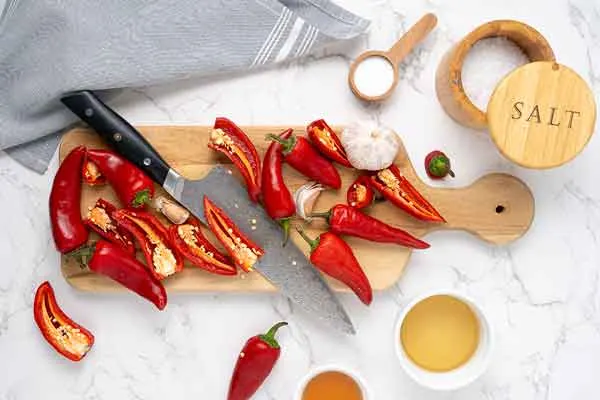
Puree and ferment. For the best flavor, we recommend a short ferment. The classic zing of sriracha comes from the fermentation process. Fermenting is optional, but highly recommended (it takes about a week for this recipe). Puree the peppers and garlic, along with the sugar, salt, and water.
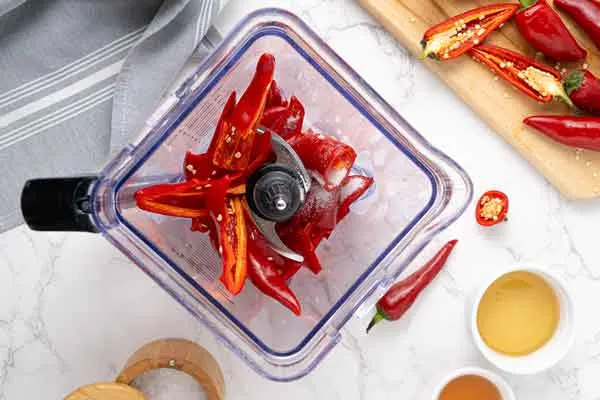
Transfer the mixture to a clean glass jar to ferment for about a week in a dark place at room temperature. It’s important to keep your ferment out of direct sunlight. Cover with an airlock lid or a clean cloth to allow gas to escape. Check in on the mixture every couple days as the sauce ferments.
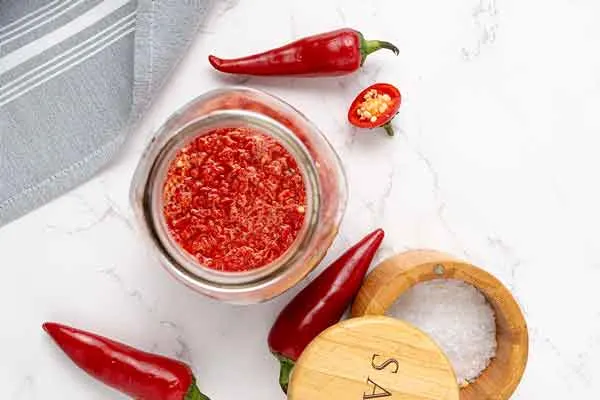
Blend up the sauce. Once fermentation is complete, add to a high-powered blender with the vinegar and honey. Puree until blended and smooth. You can also use an immersion blender for this process.
Strain and deglaze. Strain the pepper mash with a fine mesh strainer into a saucepan or small pot and simmer over medium heat until the hot sauce is at the desired consistency. Season with salt to taste.
Add into hot sauces bottles and or airtight container and store into refrigerator for up to 6 months.
Fermentation tips
If fermentation is new to you, there are a few important things to know before getting started. These tips will help you avoid common mistakes and help you get the best tasting sriracha sauce possible.
- Oxygen is the enemy. Fermentation is essentially the slow, controlled breakdown of foods. By combining fresh produce with salt, and removing oxygen, you encourage lactobacillus to thrive and consume the carbohydrates in the food. Exposing the raw produce to oxygen during fermentation may invite mold to grow, potentially spoiling the ferment.
- Use fresh produce. Get the freshest produce possible for best results. Older peppers may have already begun to decompose, leading to a spoiled ferment.
- Allow for gas to escape. As the sauce ferments, it will produce CO2. If you seal your jars, they will build up pressure, potentially leading to an explosion. To avoid this, use an air exchange lid which allows gasses to escape, but not to enter back into the vessel.
- Make a cartouche. As an extra step against oxygen exposure, you can cover the top of your pepper mixture with a cartouche. Using parchment paper, cut a circle to the same size as your jar’s diameter, then cover the top of the ferment to block air exposure.

Hot sauce is one of our favorite homemade condiments. We actually did a blind taste test with a few friends, and our version came out ahead of some popular store-bought sauces. Once you make your own hot sauce, it’s hard to go back to anything you can buy in the store.
Our other hot sauce recipes

Sriracha Hot Sauce
Ingredients
- 1.5 lb red chiles red jalapeños or fresnos
- 3 large garlic cloves
- 1/2 cup water distilled or spring
- 2 Tbsp. sugar
- 1 Tbsp. kosher salt
- 1 Tbsp. honey
- 1/2 cup rice vinegar
Instructions
- Cut the red peppers lengthwise, removing the seeds and the pith. Slice the garlic.
- Puree the peppers and garlic along with the sugar, salt, and water and transfer the mixture into a jar.
- Cover jar with a clean cloth or airlock lid and leave to ferment at room temperature for about 1 week. Fermentation is optional but recommended for the best flavor.
- Once fermentation is complete, add to a blender with the vinegar and honey and blend on high until smooth.
- Strain the sauce through a fine-mesh strainer into a saucepan. Simmer over medium heat until the hot sauce reaches the desired consistency (slightly thickened is ideal). Salt to taste.
- Add into hot sauces bottles or an airtight container and store in the refrigerator for up to 6 months.
Notes
- Fermentation is optional, but recommended for the richest flavor. 1 week is a relatively short fermentation, so feel free to extend the time to your tastes. Learn more about fermentation here.
